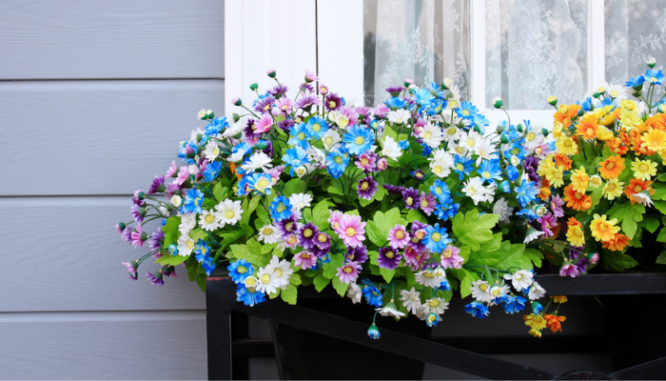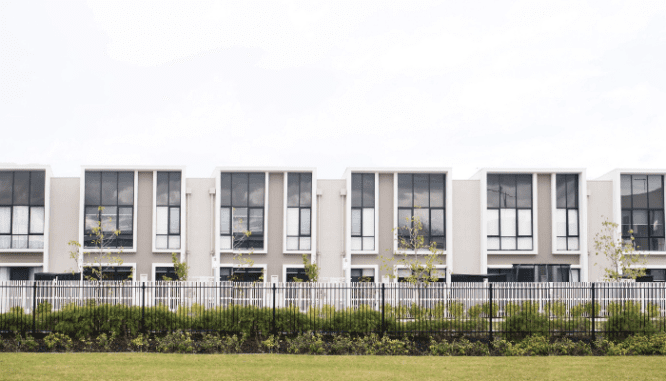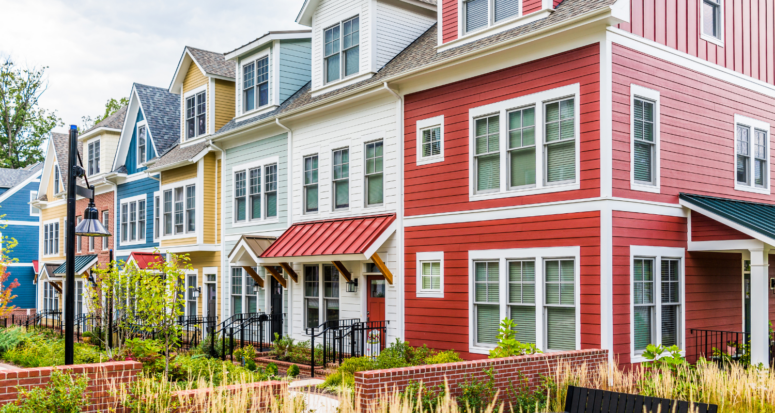Here’s a Challenge: How Do You Put Curb Appeal on a Townhouse?
- Published on
- 4-5 min read
-
 Christine Bartsch Contributing AuthorClose
Christine Bartsch Contributing AuthorClose Christine Bartsch Contributing Author
Christine Bartsch Contributing AuthorFormer art and design instructor Christine Bartsch holds an MFA in creative writing from Spalding University. Launching her writing career in 2007, Christine has crafted interior design content for companies including USA Today and Houzz.
Scratching your head to come up with great townhouse curb appeal ideas? It’s no wonder you need inspiration: Single-family homes steal all the attention in real estate as the preferred home type among Americans. Out of the 352,000 newly built multifamily units completed in 2019, only 3,000 were townhouses. And in 2020, townhouses accounted for only 7% of home purchases among all buyers.
But being in the minority doesn’t detract from your pride as a townhouse owner. Plus, if you’re thinking of selling that townhouse anytime soon, you’ll need to spruce up the exterior to attract buyers and stand out in a row of uniformity.
Ignore that you’re working with a tiny front yard. Put aside your concerns about shared walls and HOA restrictions that make it difficult to adapt generic curb appeal advice. With this guide, we’ll help you achieve the amazing townhouse curb appeal your single-family-touting neighbors would die for.

Know the HOA rules before you begin
Whether you have an HOA governing your townhouse community will determine which curb appeal projects you’re allowed to take on.
“We own several townhomes and they are individually deeded, which means we’re responsible for our own curb appeal, roof, siding, and our own paint,” explains Carrie Routt, a top-selling real estate agent in Panama City, Florida. “With no governing HOA, I could paint mine purple and my neighbor could paint theirs green. Whereas in HOA-governed townhome communities, I couldn’t paint my townhome a unique color. They’re all painted a uniform color by the association using funds from the reserve account that you pay into monthly.”
So, you’re good to go if your townhouse isn’t restricted by a homeowner’s association (HOA). But if your community does have one, you need to review your HOA’s CCRs (Covenants, Codes, and Restrictions) before you make any curb appeal plans.
There are two main types of HOA associations: ones that handle all exterior maintenance, including the landscaping, and ones that handle just the exterior building maintenance while leaving the yard maintenance to the townhome owner.
In either case, any major changes to your curb appeal typically must be approved by the association. Whether your HOA is relaxed and casual, or nitpicky and strict, there’s bound to be a few rules that limit what you can do to your home’s exterior and your front yard, including:
- Restricting exterior paint colors
- Landscaping maintenance or changes
- Changes to exterior light fixtures, mailboxes, or house numbers
- Attaching decor to your exterior (flagpoles, trellises, shutters, flowerboxes, etc.)
- Adding permanent or semipermanent structures
Now, let’s look at how you can add curb appeal to your defined space and use the house as your canvas with these seven townhouse-specific curb appeal tips.
1. Display tasteful garden sculptures
The CCRs governing what’s allowable in your front yard don’t have to totally cramp your townhouse curb appeal style. While CCRs restrict you from making permanent changes to your front yard, most allow you to personalize the space with garden sculptures as long as the pieces are moveable and not permanently installed.
A garden sculpture not only adds an eye-catching décor statement, it also serves as a visible way for people to identify your unit among your identical neighbors without straining to read the house numbers.
Steer clear of cheesy garden statuary like gnomes, frogs, and human figures. Stick instead to statues in styles with universal appeal, like this modern orb garden sculpture for $129, or this cast stone obelisk finial for $267.
If your townhouse needs more color than metal or stone statues can offer, consider installing a reflective garden globe for around $70 to $90.

2. Install window boxes to add color and greenery
When your townhouse doesn’t have much outdoor space for adding eye-catching greenery, window boxes filled with colorful plants are ideal for improving curb appeal.
You can buy window boxes from any major home improvement retailer. They come in a variety of colors and styles to match your home, and you can spend as little as $10 or as much as $100 on a single box depending on how high-end you want to go.
You can hang window boxes yourself with a drill, 3-inch galvanized screws, and this handy guide from This Old House, a 40-year-old home-enthusiast brand. (Make sure to choose a window box that’s about 6 inches longer than the window).
If your HOA forbids you from directly mounting your window boxes on the exterior or your townhouse, you still have options. Some window boxes, also known as deck rail planters, are designed to hang from porch rails without permanently attaching them.
According to the Old Farmer’s Almanac, a periodical started in 1792, window boxes look best with lots of plants arranged close together. The Almanac recommends anchoring your window box with some base flowers like:
- Petunias
- Geraniums
- Zinnias
- Nasturtiums
3. Flank your front door with towering topiaries
If your front door is the only outdoor area you have domain over out front, you can transform the tiny space into a showplace with a pair of towering topiaries. Flank your front door with topiaries, and all of a sudden you’ve got a grand entrance.
Pro tip: Opt for artificial topiaries, like this pair of spiral topiary trees for $130 or two of these artificial double ball topiary trees at $230 each. This will eliminate the need to maintain the shape of the topiaries with careful pruning if you’ve got a busy schedule.
Many artificial topiaries like the ones above come in the same plastic pots as live plants, so that you can pick planters that match your townhome’s style, whether that would be sleek and modern planters or classic urns.
4. Install trellises or arches for vining plants
Townhouses are typically two stories or more, so you can’t restrict your curb appeal plans to the ground floor only. While your HOA may not allow you to add architectural details, like shutters, to your upper levels, you can give your curb appeal some height with greenery — as long as it does not attach to the building itself (which is typically the responsibility of the HOA).
Greenery growing on freestanding trellises and garden arbors won’t even hit the second story, however, their lean height will draw the eye upward and include your upper levels in your curb appeal story.
You can pick up trellises, arbors, and other vine support options for as little as $15 and up into the hundreds, depending on the design and construction materials.
A bare trellis won’t do much to improve your curb appeal, so make sure to pick up a fast-growing vine to plant alongside it. The gardening pros at MiracleGro recommend:
- Orange trumpet vine
- Climbing hydrangea
- Clematis flowering vine
- Bougainvillea
- Honeysuckle vine
5. Create height in your flower beds with tall container gardens
Depending on your townhome’s design and your HOA’s rules, you may not have the space or permission to add a structure as sizable as a trellis to your petite front yard. That doesn’t mean you need to abandon your quest for height. You can create a similar effect by varying the height of plantings in your flower beds with tall planters.
With single-family homes, gardeners have the space to add depth and dimension to their landscaping plans by creating small hills and valleys. But if you add extra earth around your house incorrectly, you create drainage issues that can lead to foundation damage. This is a huge problem for townhouses, where you’re literally attached to your neighbors.
Adding container gardens to your in-ground flower beds creates elevation without altering the terrain. Get even more height in your container gardens by adding classic tuteurs and climbing plants that grow well in containers, such as:
- English ivy
- Wisteria
- Mandevilla
- Star jasmine
Container gardens also offer you the opportunity to add pops of color to your townhouse’s curb appeal, without violating most CCRs. There are any number of flowering plants that grow well in containers, and you can boost those hues by planting them in colorful containers. If flowers aren’t your thing, opt for outdoor plants that have colorful leaves or interesting textures.

6. Plant hedges along your property line for privacy
Tall greenery does more than bring attention to your townhouse’s height; it also creates a natural privacy screen between you and your neighbors. As an added bonus, some property line plants also act as a natural noise reducer.
Get year-round privacy by selecting evergreen shrubs that won’t lose their leaves in the winter. Boxwood shrubs are a popular choice for creating privacy hedges, as most varieties are hearty and easily shaped.
Trees, however, are not ideal for creating privacy fences for townhouses. For example, leyland cypress trees are practically iconic as a natural privacy fence option for single-family homes. But they are not ideal for townhouses because they grow too tall, reaching heights of 60 to 70 feet.
7. Use a shed to hide eyesores
Whether you have a lawn, trees, shrubs, or container gardens, greenery requires maintenance — and that creates a unique problem for townhouse sellers.
“Front yard maintenance can be a challenge in townhomes because you don’t have exterior access between your front and back yards. So how are you going to get the lawnmower to the front yard? Roll it through your kitchen?” asks Routt.
Luckily, townhouse front yards are typically tiny, so you can use a weed wacker to trim it. But you still need a space to hide it and other front yard garden tools.
One possibility is installing a tall, narrow freestanding tool shed in an out-of-the-way corner that won’t mar the overall curb appeal of your townhouse. If there’s no space for standing storage, an outdoor bench with built-in storage is your next best option.

Community conformity is not a negative
When you’re desperate to transform your townhouse’s exterior into a showstopper, it can be a little daunting when you read through your HOA’s extensive CCRs. But don’t forget the silver lining.
Having an HOA actually takes some of the burden off your shoulders because you won’t need to lay out thousands to repaint your home or redo the roof.
As for non-HOA townhouse owners, take note: Being free of community restrictions should not be treated as a license to go crazy with creative curb appeal. That’s a big mistake when you’re attached to your neighbor.
“One of the downfalls about a townhome is when people get really individual with their units. I personally like it when all the exterior lighting, house numbers, and mailboxes match,” explains Routt.
“When you’ve got different mailboxes, different colored doors, different colored siding, and so forth on connected townhouses, everything looks a little hodgepodge which ends up detracting from the community.”
Rather than going as unique as you can with a single-family home, play it cool with your creativity, keep it tasteful, and craft curb appeal plans that embrace townhouse living.
Header Image Source: (Kristi Blokhin / Unsplash)
